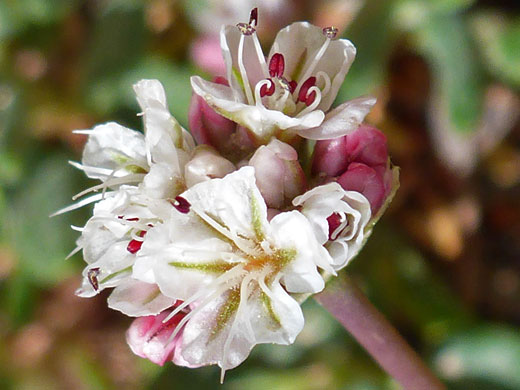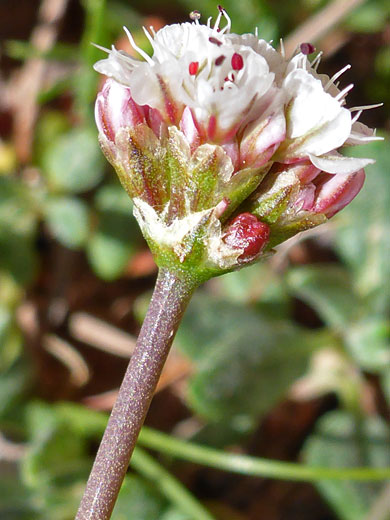Eriogonum Panguicense, Panguitch Buckwheat
Plants > Wildflowers > Polygonaceae > Eriogonum Panguicense

Panguitch buckwheat (eriogonum panguicense var alpestre), Ramparts Trail, Cedar Breaks National Monument, Utah
Common name:
Panguitch buckwheat
Family:
Scientific name:
Eriogonum panguicense
Main flower color:
Range:
Southwest Utah
Height:
Up to 7 inches
Habitat:
Coniferous woodland, sagebrush, clayish slopes, from 5,500 to 11,000 feet
Leaves:
Basal, short-stalked, sparsely hairy; blades are elliptic to narrowly oblanceolate, up to 2 inches long
Season:
June to August
Eriogonum panguicense has restricted distribution across the mountains of southwestern Utah, including the Sevier, Aquarius and Markagunt Plateaus. Plants have an open, matted appearance, with clustered basal leaves, short stems (one to two inches), and longer, leafless stalks topped by dense, spherical clusters, less than one inch across. Stalks (and stems) are spreading rather than erect. Leaves are densely hairy underneath, less so above. Leaf margins may be straight or slightly wavy-toothed.
The inflorescence contains up to seven involucres, each typically holding four flowers; these have white tepals with reddish-green median ridges, and exserted stamens. Filaments of the stamens are white, hairy towards the base, while anthers are purplish, and relatively large.
Most specimens of eriogonum panguicense are var panguicense, characterized by leaves up to 2 inches long and flower stalks up to 7 inches; the less common var alpestre, restricted to barren slopes and ridges in Cedar Breaks National Monument, has leaves less than 1 inch long and flower stalks only up to 3 inches.
The inflorescence contains up to seven involucres, each typically holding four flowers; these have white tepals with reddish-green median ridges, and exserted stamens. Filaments of the stamens are white, hairy towards the base, while anthers are purplish, and relatively large.
Most specimens of eriogonum panguicense are var panguicense, characterized by leaves up to 2 inches long and flower stalks up to 7 inches; the less common var alpestre, restricted to barren slopes and ridges in Cedar Breaks National Monument, has leaves less than 1 inch long and flower stalks only up to 3 inches.
All Contents © Copyright The American Southwest | Comments and Questions | Contribute | Site Map




